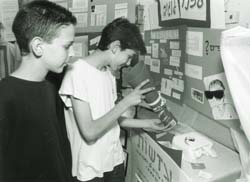
There is barely an inch of the noisy hall in Katzir B Junior High School in Rehovot that is not filled with colorful posters and oddly-shaped models illustrating a variety of topics under the heading of "Senses and Sensors." Children throng round tables, showing off their hard work to parents and teachers.
Adar Kipper,14, prepared the display by herself for her science class. "If I had learned all this in class I don't think I would have taken it all in," she says, turning towards her exhibit which explains with the aid of text, intricate diagrams and photographs, how birds navigate through the skies. Her classmates fell over each other in their eagerness to describe what they had learned in the framework of a new hands-on approach to science teaching developed at the Weizmann Institute.
Israeli junior high school children have always taken classes in physics, chemistry, biology and mathematics. However, the breadth and depth of these topics was rather limited. What is changing is the focus, following the government's adoption in 1993 of the recommendations of the "Tomorrow 98" report, prepared by a commission headed by Professor Haim Harari, President of the Weizmann Institute.
"The report emphasizes the importance of scientific literacy for all citizens," explains Prof. Uri Ganiel, head of the Weizmann Institute's Science Teaching Department, who was a member of the Harari commission. "One of its recommendations is that a new topic, called 'Science and Technology for Junior High Schools,' be introduced into the junior high school curriculum." The Weizmann Institute was one of two academic institutions in Israel asked to develop courses to implement this recommendation.
"Previously, a child in a science class had 'personal knowledge' -- only he and perhaps the teacher knew how much he knew," explains Prof. Bat-Sheva Eylon of the Science Teaching Department, who directs the project. "Now, pupils prepare exhibitions to provide shared knowledge, to show what they are doing."
In devising the exhibition, the pupils learn the rudiments of scientific research: how to formulate questions and how to find the answers, just like scientists. "The purpose isn't the exhibit, it's the process," says Eylon.
The only way to gauge how teachers and pupils would react to this new approach was to take it out of academia and into the field. Thus Project Rehovot was born.
The Katzir A and B and De-Shalit A and B Junior High Schools were chosen to take part, and in the 1997/98 academic year the project was implemented in the 7th grade. Eighth graders have already joined the project and soon 9th graders will also be testing out the Institute's concepts. "The dedication of the teachers and their enthusiasm have been essential factors in the success of the project," says Ganiel.
The vibrant displays at the schools and the excited, chattering pupils made it clear just how much the students gain from being freed from a traditional, blackboard-based, "teacher-faces-class" environment. "We learned scientific thinking," says 14-year-old Izhar Arieli from Katzir B Junior High, whose project dealt with the differences between human sight and feline sight. "We learned how to do experiments, write introductions."
His classmate, Omer Vered, built a model utilizing a Pringles tube to compare the behavior of concave and convex lenses. "It was my idea," he says proudly. "The project was really good because there's a real product; it's not just written down in a book. And everyone can see what you've done -- not just the teacher."
Schoolchildren are not the only ones to be influenced by this project. Ganiel: "The teaching profession in the sciences may be on the brink of a dramatic change -- the teacher-turned-supervisor will need to continually study the fields each student chooses to research. The teaching profession will be marked by lifelong learning."
